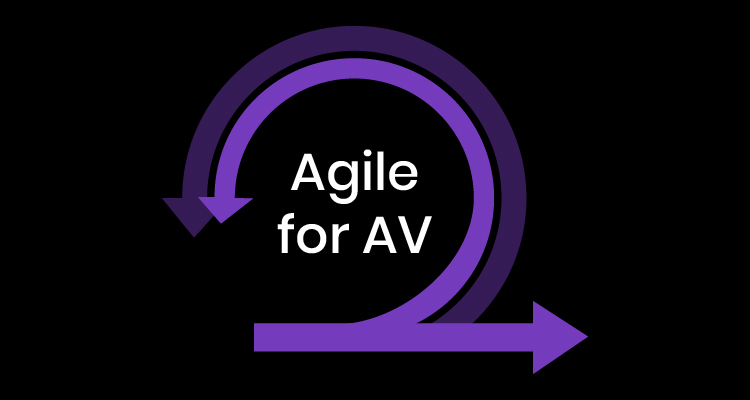Agile for AV: Go-To-Market Strategies for AV Firms

The problem is not your technology. The problem is that you can’t pivot fast enough to keep up with the changes (set in motion by a global pandemic). The reason you can’t keep up is that your management system is based on a static, backward-looking, historical view of the AV market because it’s always worked, until it didn’t.
At rAVe, we’ve been talking for years now about the need for the AV industry to shift to a world that has become agile as consumer technology introduced the ability to push change nearly instantaneously. Blame it on apps, or even the smartphones that made apps possible, but you’ll need to get over these excuses quickly because languishing over the past isn’t going to change your future.
Let’s cut to the chase. The world has changed. There’s no going back, but would you really want to go back to a world where you had to respond slowly and hope to catch up? While the future of the entertainment industry as a whole and the AV industry are in question in terms of the economy and large-venue gatherings being out of play, what will replace the status quo is a “new normal.” However, it won’t look normal. We at rAVe are not here to prognosticate about precisely what the future will look like, except to say that we do know what it will include: faster change.
Guiding Principles for Pivoting Faster
In 2001, the software industry changed forever with the advent of Agile. Today, almost all software is created in an Agile fashion — taking small, bite-sized chunks of work and delivering value faster and learning from feedback as it comes in — so that new software is released sooner and more in line with the needs of the consumer. The principles, processes and practices of Agile have led to unprecedented successes in business. Google, Amazon, Facebook, Uber, Spotify, Airbnb — all of them are Agile-based companies. Plus, their meteoric rise was entirely made possible by the principles of Agile.
Agile thinking is different from how companies have been managed using traditional hierarchical organizational matrices and command-and-control decision-making. It is likely your business is still based on more conventional-based management ideologies, structures and cultures — things like focusing on profits first, having individuals fit to roles and enforcing clear authority lines. This structure worked quite well for most of the 20th century. However, today’s rate of change is greater than your ability to change with it when you stick with this type of authoritarian construct. That’s why we focus on guiding principles for pivoting faster.
The differences are stark: Agile thinking focuses on primarily creating more value for customers where profits are the byproduct, not the goal; it eliminates standardized roles in favor of small, self-organizing teams working together for short durations as needed; and it pushes control down with delegated authority while ensuring technical competence is shared among team members. These principles set the stage for pivoting faster, because when it’s more important to deliver value than to make your boss happy, you begin to see a change in the culture. And with it comes greater clarity of purpose for unleashing innovation.
Process Changes That Change Everything
Supporting these principles are the processes by which decisions are made, and the work flows freely to deliver greater value at scale. Things like leadership, strategy, innovation, management, budgeting, metrics and even risk management are done inherently differently when viewed through the lens of those guiding principles.
An agile mindset believes that every person has the potential to lead. People with this mindset also believe that those doing the work are closest to solving the problems and, as a result, creating a better strategy from practical insights. Innovation is curated by a culture that focuses on better outcomes instead of more outputs. Management changes from telling people what to do and inspecting their work to asking how to understand the work and removing impediments to a team’s success. Risk is viewed as opportunistic because failure isn’t final but rather a proving ground for discovering the best possible value for the client.
When processes are identified that slow down delivery value, they are inspected and adapted so that they can be changed or eliminated. And when processes reveal the opportunity to retool or even re-imagine, they are immediately tested and validated with data and feedback.
Fluid Practices From Real-Time Feedback
Faster still are the practices: These are things like habits, attitudes, cultural values and cultural tone. In fact, Agile is — at its core — an infinitely valuable culture play. Transforming from command-and-control to self-directed teams aligned to clear principles and defined outcomes for delivering customer value is perhaps the game-changer for almost every kind of organization; it certainly is for the AV manufacturer, systems integrator, dealer, distributor and consulting firm.
Agility is about prioritizing work, measuring progress as you go, learning from those measurements via real-time feedback, and reporting what’s working and not working. All this adds value to the customer. Knowing both, what’s working and not working, is highly valued in a “failure-is-an-option” culture in which small, fast risks are expected. If nurtured, week in and week out, an Agile framework will become the new normal. And in times like these, this kind of ability to test, measure, validate and pivot quickly is required.
“Agile for AV” may not yet be a term, but because Agile has already proven itself in many other areas, it’s just a matter of time before it’s the new normal. And the firms that embrace business agility will have a stupendous competitive advantage.





